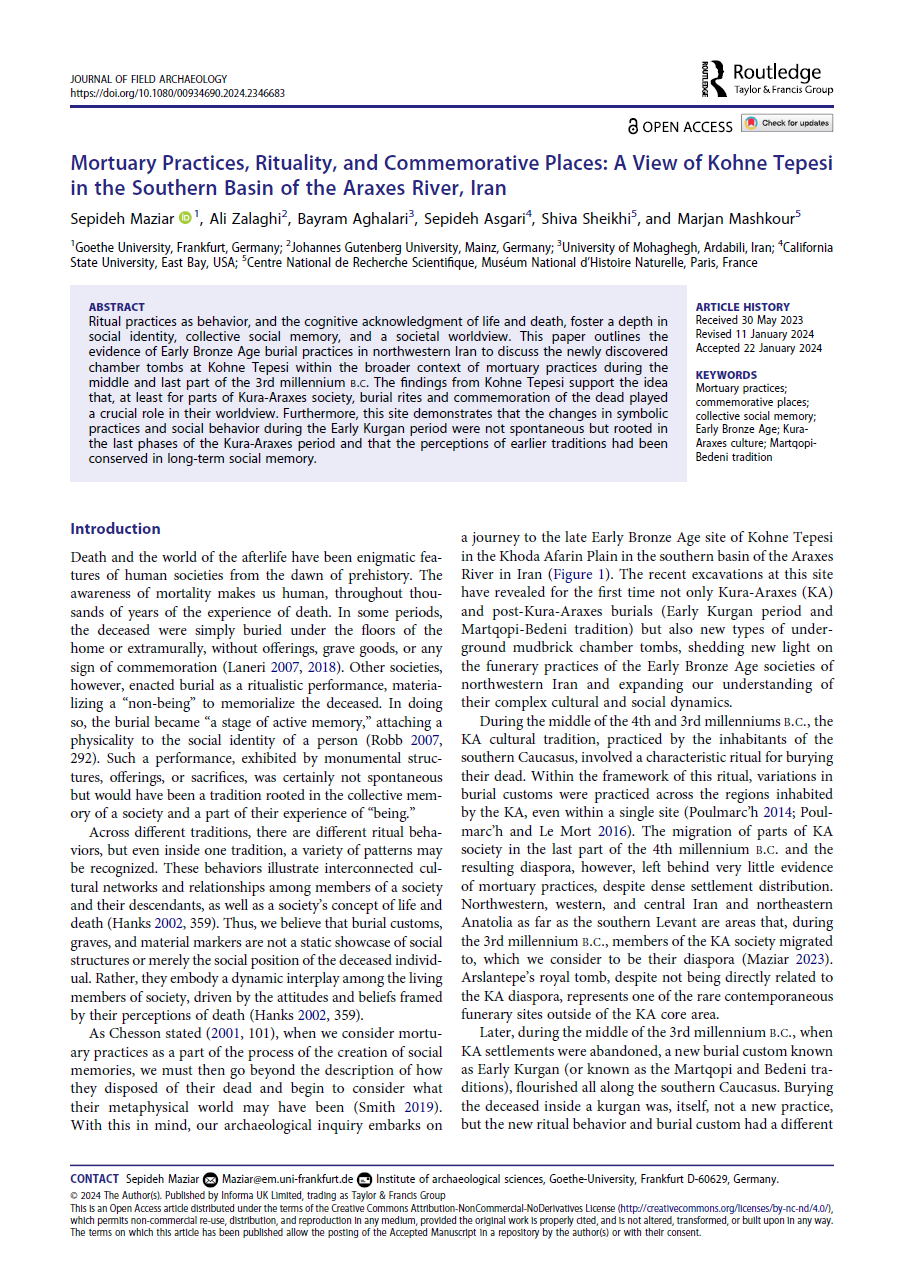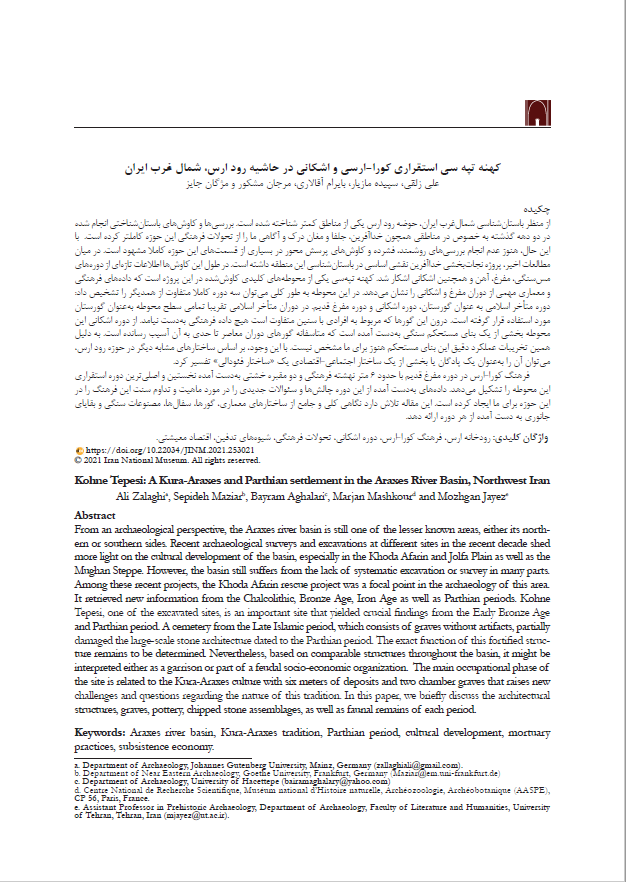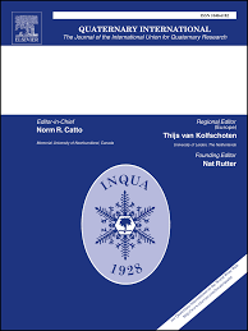Publications so far
0
| 1. |  | Maziar, Sepideh; Zalaghi, Ali; Aghalari, Bayram; Asgari, Sepideh; Sheikhi, Shiva; Mashkour, Marjan: Mortuary Practices, Rituality, and Commemorative Places: A View of Kohne Tepesi in the Southern Basin of the Araxes River, Iran. In: Journal of Field Archaeology, 2024. (Type: Journal Article | Abstract | Links | BibTeX)@article{nokey,Ritual practices as behavior, and the cognitive acknowledgment of life and death, foster a depth in social identity, collective social memory, and a societal worldview. This paper outlines the evidence of Early Bronze Age burial practices in northwestern Iran to discuss the newly discovered chamber tombs at Kohne Tepesi within the broader context of mortuary practices during the middle and last part of the 3rd millennium b.c. The findings from Kohne Tepesi support the idea that, at least for parts of Kura-Araxes society, burial rites and commemoration of the dead played a crucial role in their worldview. Furthermore, this site demonstrates that the changes in symbolic practices and social behavior during the Early Kurgan period were not spontaneous but rooted in the last phases of the Kura-Araxes period and that the perceptions of earlier traditions had been conserved in long-term social memory. |
| 2. |  | Maziar, Sepideh: Evaluation of the Kura-Araxes migration: From a mono-factorial phantasm to a multi-dimensional phenomenon. In: Kosyan, Aram; Avetisyan, Pavel; Martirosyan-Olshansky, Kristine; Bobokhyan, Arsen; Grekyan, Yervand (Ed.): Paradise Lost. The Phenomenon of the Kura-Araxes Tradition along the Fertile Crescent Collection of papers honouring Ruben S. Badalyan on the occassion of his 65th birthday, Archaeopress, 2022. (Type: Book Chapter | Abstract | Links | BibTeX)@inbook{nokey,Many scholars concerned with the Kura-Araxes cultural tradition take many aspects of this complex phenomenon for granted. In most publications, the expansion of this tradition across a vast area is treated like the movement of people from point A to B, or in the best case, as the waves of movement between these points. In most of them, migration is considered a direct reaction of people to population growth, lack of pasture lands, environmental stresses, and the Kura-Araxes as environmental or conflict refugees that flee a threat. These perspectives in recent years terminated to some skeptics regarding considering the distribution of the Kura-Araxes material culture as a result of migration. On the other hand, turning to be once again a buzzword, ‘migration’ as an explanation, is considered anachronistic among some archaeologists. This article will reevaluate different scenarios related to the Kura-Araxes phenomenon to see where we stand and how we can overcome these shortcomings. It seems that the Kura-Araxes phenomenon at the current state of our understanding suffers different drawbacks at different levels. The migration scenario itself and the mechanism behind it are still vague, and the relationship between the core area and diaspora is rarely addressed. It is suggested that approaches such as ‘resilience theory’ and discussing the Kura- Araxes phenomenon and migration in the context of social resilience will be more promising for the topic at hand. |
| 3. |  | Zalaghi, Ali; Maziar, Sepideh; Aghalari, Bayram; Mashkour, Marjan; Jayez, Mozhgan: Kohne Tepesi: A Kura-Araxes and Parthian settlement in the Araxes River Basin, Northwest Iran. In: Journal of Iran National Museum, vol. 2, no. 1, 2021. (Type: Journal Article | Abstract | Links | BibTeX)@article{nokey,From an archaeological perspective, the Araxes river basin is still one of the lesser known areas, either its northern or southern sides. Recent archaeological surveys and excavations at different sites in the recent decade shed more light on the cultural development of the basin, especially in the Khoda Afarin and Jolfa Plain as well as the Mughan Steppe. However, the basin still suffers from the lack of systematic excavation or survey in many parts. Among these recent projects, the Khoda Afarin rescue project was a focal point in the archaeology of this area. It retrieved new information from the Chalcolithic, Bronze Age, Iron Age as well as Parthian periods. Kohne Tepesi, one of the excavated sites, is an important site that yielded crucial findings from the Early Bronze Age and Parthian period. A cemetery from the Late Islamic period, which consists of graves without artifacts, partially damaged the large-scale stone architecture dated to the Parthian period. The exact function of this fortified structure remains to be determined. Nevertheless, based on comparable structures throughout the basin, it might be interpreted either as a garrison or part of a feudal socioeconomic organization. The main occupational phase of the site is related to the Kura-Araxes culture with six meters of deposits and two chamber graves that raises new challenges and questions regarding the nature of this tradition. In this paper, we briefly discuss the architectural structures, graves, pottery, chipped stone assemblages, as well as faunal remains of each period. |
| 4. |  | Maziar, Sepideh: Geographical Proximity and Material Culture; The Interplay Between Syunik and the Southern Part of the Araxes River Basin in the 6th to the 3rd Millennium BC. In: Quaternary International, iss. 579, pp. 42-58, 2021. (Type: Journal Article | Abstract | Links | BibTeX)@article{nokey,The region that is known today as Syunik in the south/southeastern part of Armenia is geographically a close neighbour of the southern part of the Araxes river basin in today Iran. Political upheavals and boundaries hindered fieldwork in these areas for many years. The archaeological project of the Araxes valley (APAV) is one of many other projects that launched in 2013 in this region and focused on the southern basin of the Araxes River. The results of the excavations of two sites, Kohne Pasgah Tepesi and Kohne Tepesi, and the intensive survey carried out in this area, enable us to shed more light on the settlement dynamics, material culture and economic/social networks of this area and its neighbours. The period from the 6th up to the middle part of the 4th millennium BC represents the Neolithic and Chalcolithic periods in this region. The material culture of both periods shares many common characteristics with contemporary traditions at sites of the southern Caucasus. Later, in the last part of the 4th millennium BC, a cultural tradition that originated in the southern Caucasus, known as the Kura-Araxes cultural tradition, expanded over a vast area, including the southern part of the Araxes river basin. Based on the study of the pottery styles and obsidian flow, the patterns of interconnection between regions, communities, and sources, and commodity flows are examined. The role of the Araxes River and its tributaries in this interplay over the stated time span is the other inquiry of this article. Furthermore, I will investigate whether spatial propinquity had any impact on commodity flows and exchange, and if so, did this impact affected the material culture and technological practices or not. |
| 5. |  | Maziar, Sepideh; Zalaghi, Ali: Exploring Beyond the River and Inside the Valleys: Settlement Development and Cultural Landscape of the Araxes River Basin Through Time. In: Iran, iss. 59, pp. 36–56, 2020. (Type: Journal Article | Abstract | Links | BibTeX)@article{nokey,Geographical landmarks, especially rivers, have always played an important role in forming or hampering interplay between societies. In some cases, they act as a “communication route” and in some others as “obstacles”. In north-western Iran, it is possible that the Araxes River played such a decisive role by sculpting its surroundings. While our studies are not yet sufficiently adequate to understand the exact role of this river in different time spans, we can begin in some way to conceptualise its role in different periods. The Araxes Valley Archaeological Project (AVAP) was developed with the general aim of investigating settlement development from the fifth to the third millennium BC. Furthermore, studying the possible and probable routes of interaction, both inter- and intra-regional, between the Jolfa and Khoda Afarin plains and the southern Caucasus and north-western Iran, networks of contacts and exchange, and gaining a better understanding of the geographical characteristics of this area and its landscape were among our aims. In this article, the general history of occupation along this river is given to provide a preliminary database to understand the geographical and socio-political potential of this part in order to pursue more comprehensive studies in the future. |
2024 |
|
 | Maziar, Sepideh; Zalaghi, Ali; Aghalari, Bayram; Asgari, Sepideh; Sheikhi, Shiva; Mashkour, Marjan: Mortuary Practices, Rituality, and Commemorative Places: A View of Kohne Tepesi in the Southern Basin of the Araxes River, Iran. In: Journal of Field Archaeology, 2024. (Type: Journal Article | Abstract | Links | BibTeX | Tags: Bronze Age, Kura-Araxes, Social)@article{nokey,Ritual practices as behavior, and the cognitive acknowledgment of life and death, foster a depth in social identity, collective social memory, and a societal worldview. This paper outlines the evidence of Early Bronze Age burial practices in northwestern Iran to discuss the newly discovered chamber tombs at Kohne Tepesi within the broader context of mortuary practices during the middle and last part of the 3rd millennium b.c. The findings from Kohne Tepesi support the idea that, at least for parts of Kura-Araxes society, burial rites and commemoration of the dead played a crucial role in their worldview. Furthermore, this site demonstrates that the changes in symbolic practices and social behavior during the Early Kurgan period were not spontaneous but rooted in the last phases of the Kura-Araxes period and that the perceptions of earlier traditions had been conserved in long-term social memory. |
2022 |
|
 | Maziar, Sepideh: Evaluation of the Kura-Araxes migration: From a mono-factorial phantasm to a multi-dimensional phenomenon. In: Kosyan, Aram; Avetisyan, Pavel; Martirosyan-Olshansky, Kristine; Bobokhyan, Arsen; Grekyan, Yervand (Ed.): Paradise Lost. The Phenomenon of the Kura-Araxes Tradition along the Fertile Crescent Collection of papers honouring Ruben S. Badalyan on the occassion of his 65th birthday, Archaeopress, 2022. (Type: Book Chapter | Abstract | Links | BibTeX | Tags: Bronze Age, Kura-Araxes, Mobility, Resilience, Translocality)@inbook{nokey,Many scholars concerned with the Kura-Araxes cultural tradition take many aspects of this complex phenomenon for granted. In most publications, the expansion of this tradition across a vast area is treated like the movement of people from point A to B, or in the best case, as the waves of movement between these points. In most of them, migration is considered a direct reaction of people to population growth, lack of pasture lands, environmental stresses, and the Kura-Araxes as environmental or conflict refugees that flee a threat. These perspectives in recent years terminated to some skeptics regarding considering the distribution of the Kura-Araxes material culture as a result of migration. On the other hand, turning to be once again a buzzword, ‘migration’ as an explanation, is considered anachronistic among some archaeologists. This article will reevaluate different scenarios related to the Kura-Araxes phenomenon to see where we stand and how we can overcome these shortcomings. It seems that the Kura-Araxes phenomenon at the current state of our understanding suffers different drawbacks at different levels. The migration scenario itself and the mechanism behind it are still vague, and the relationship between the core area and diaspora is rarely addressed. It is suggested that approaches such as ‘resilience theory’ and discussing the Kura- Araxes phenomenon and migration in the context of social resilience will be more promising for the topic at hand. |
2021 |
|
 | Zalaghi, Ali; Maziar, Sepideh; Aghalari, Bayram; Mashkour, Marjan; Jayez, Mozhgan: Kohne Tepesi: A Kura-Araxes and Parthian settlement in the Araxes River Basin, Northwest Iran. In: Journal of Iran National Museum, vol. 2, no. 1, 2021. (Type: Journal Article | Abstract | Links | BibTeX | Tags: Kura-Araxes, Parthian, Settlement structure)@article{nokey,From an archaeological perspective, the Araxes river basin is still one of the lesser known areas, either its northern or southern sides. Recent archaeological surveys and excavations at different sites in the recent decade shed more light on the cultural development of the basin, especially in the Khoda Afarin and Jolfa Plain as well as the Mughan Steppe. However, the basin still suffers from the lack of systematic excavation or survey in many parts. Among these recent projects, the Khoda Afarin rescue project was a focal point in the archaeology of this area. It retrieved new information from the Chalcolithic, Bronze Age, Iron Age as well as Parthian periods. Kohne Tepesi, one of the excavated sites, is an important site that yielded crucial findings from the Early Bronze Age and Parthian period. A cemetery from the Late Islamic period, which consists of graves without artifacts, partially damaged the large-scale stone architecture dated to the Parthian period. The exact function of this fortified structure remains to be determined. Nevertheless, based on comparable structures throughout the basin, it might be interpreted either as a garrison or part of a feudal socioeconomic organization. The main occupational phase of the site is related to the Kura-Araxes culture with six meters of deposits and two chamber graves that raises new challenges and questions regarding the nature of this tradition. In this paper, we briefly discuss the architectural structures, graves, pottery, chipped stone assemblages, as well as faunal remains of each period. |
 | Maziar, Sepideh: Geographical Proximity and Material Culture; The Interplay Between Syunik and the Southern Part of the Araxes River Basin in the 6th to the 3rd Millennium BC. In: Quaternary International, iss. 579, pp. 42-58, 2021. (Type: Journal Article | Abstract | Links | BibTeX | Tags: Bronze Age, Chalcolithic, Economy, Kura-Araxes, Neolithic, Settlement mobility, Social, social relations, Survey)@article{nokey,The region that is known today as Syunik in the south/southeastern part of Armenia is geographically a close neighbour of the southern part of the Araxes river basin in today Iran. Political upheavals and boundaries hindered fieldwork in these areas for many years. The archaeological project of the Araxes valley (APAV) is one of many other projects that launched in 2013 in this region and focused on the southern basin of the Araxes River. The results of the excavations of two sites, Kohne Pasgah Tepesi and Kohne Tepesi, and the intensive survey carried out in this area, enable us to shed more light on the settlement dynamics, material culture and economic/social networks of this area and its neighbours. The period from the 6th up to the middle part of the 4th millennium BC represents the Neolithic and Chalcolithic periods in this region. The material culture of both periods shares many common characteristics with contemporary traditions at sites of the southern Caucasus. Later, in the last part of the 4th millennium BC, a cultural tradition that originated in the southern Caucasus, known as the Kura-Araxes cultural tradition, expanded over a vast area, including the southern part of the Araxes river basin. Based on the study of the pottery styles and obsidian flow, the patterns of interconnection between regions, communities, and sources, and commodity flows are examined. The role of the Araxes River and its tributaries in this interplay over the stated time span is the other inquiry of this article. Furthermore, I will investigate whether spatial propinquity had any impact on commodity flows and exchange, and if so, did this impact affected the material culture and technological practices or not. |
2020 |
|
 | Maziar, Sepideh; Zalaghi, Ali: Exploring Beyond the River and Inside the Valleys: Settlement Development and Cultural Landscape of the Araxes River Basin Through Time. In: Iran, iss. 59, pp. 36–56, 2020. (Type: Journal Article | Abstract | Links | BibTeX | Tags: Armenia, Azerbaijan, Bronze Age, Caucasus, Chalcolithic, Georgia, Iron Age, Kura-Araxes, Landscape, Mobility, Neolithic, Settlement and subsistance systems, Settlement mobility, Settlement structure, Structure development)@article{nokey,Geographical landmarks, especially rivers, have always played an important role in forming or hampering interplay between societies. In some cases, they act as a “communication route” and in some others as “obstacles”. In north-western Iran, it is possible that the Araxes River played such a decisive role by sculpting its surroundings. While our studies are not yet sufficiently adequate to understand the exact role of this river in different time spans, we can begin in some way to conceptualise its role in different periods. The Araxes Valley Archaeological Project (AVAP) was developed with the general aim of investigating settlement development from the fifth to the third millennium BC. Furthermore, studying the possible and probable routes of interaction, both inter- and intra-regional, between the Jolfa and Khoda Afarin plains and the southern Caucasus and north-western Iran, networks of contacts and exchange, and gaining a better understanding of the geographical characteristics of this area and its landscape were among our aims. In this article, the general history of occupation along this river is given to provide a preliminary database to understand the geographical and socio-political potential of this part in order to pursue more comprehensive studies in the future. |
